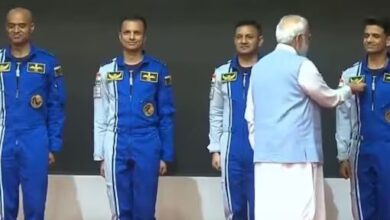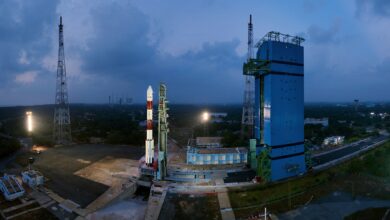India’s Historic Chandrayaan-3 Mission To The Moon Blasts Off

- Space tech is one of the most popular places for investors to put their money in India, and world leaders seem to have taken note.
- India wants to go to more places in space than just the moon and Mars. ISRO has also thought about sending a spacecraft to Venus.
With the launch of its Chandrayaan-3 mission on Friday, India hopes to become only the fourth country to land a spacecraft on the moon in a controlled way.
Chandrayaan, whose name comes from the Sanskrit word for “moon vehicle,” took off from the Satish Dhawan Space Center at Sriharikota in the southern Indian state of Andhra Pradesh at about 5 a.m. ET (2:30 p.m. local time).
People met at the space center to see the launch, which made history, and more than 1 million people watched it on YouTube.
It’s India’s second try at a soft landing. The first one, with the Chandrayaan-2 in 2019, didn’t work. Its first lunar probe, Chandrayaan-1, went around the moon and then arrived on the moon’s surface by accident in 2008.
Chandrayaan-3 was made by the Indian Space Research Organization (ISRO). It has a lander, a module for moving forward, and a robot. Its goal is to land safely on the moon’s surface, collect data, and run a set of scientific experiments to find out more about how the moon is made.
The United States, Russia, and China are the only other countries that have soft-landed a spaceship on the moon’s surface.
Engineers from India have been working on the launch for a long time. They want to land Chandrayaan-3 near the difficult South Pole of the moon, which hasn’t been explored yet.
Chandrayaan-1, India’s first journey to the moon, found water molecules on the moon’s surface. Eleven years later, the Chandrayaan-2 made it into orbit around the moon, but its robot crashed on the moon’s surface. It was also meant to look at the South Pole of the moon.
Even though the project failed, at the time, Indian Prime Minister Narendra Modi praised the engineers who worked on it and promised to keep working on India’s space program and goals.
Just before the flight on Friday, Modi said, “This day will always be written in golden letters in India’s space sector.”
In a tweet, he said, “This amazing mission will carry the hopes and dreams of our country.”
Since then, India has spent about $75 million on Chandrayaan-3.
Modi said that the rocket will travel more than 300,000 kilometers (186,411 miles) and reach the moon in the “coming weeks.”
Decades in the making
India’s space program goes back more than 60 years, when the country was just becoming a nation and was still very poor after a bloody partition.
When it sent its first rocket into space in 1963, the country was a long way behind the United States and the former Soviet Union in the race to be the first to land on the moon.
India is now the country with the most people and the fifth biggest economy in the world. It has a growing number of young people and is becoming a center for new ideas and technology.
And India’s space goals have been playing catch-up while Modi has been in charge.
India’s leader, who was elected in 2014 on a platform of nationalism and future greatness, sees the country’s space program as a sign of its growing importance on the world stage.
India was the first country in Asia to reach Mars when it sent the Mangalyaan probe into orbit around the Red Planet in 2014. The mission cost $74 million, which is less than the $100 million that Hollywood spent on the space movie “Gravity.”
Three years later, India launched 104 satellites at once, which was a world record.
In 2019, Modi said in a rare televised speech that India had shot down one of its own satellites in what it said was an anti-satellite test, making it one of only four countries to do so.
In the same year, Kailasavadivoo Sivan, who used to be the head of ISRO, said that India planned to build its own space station by 2030. At the moment, the International Space Station and China’s Tiangong Space Station are the only space stations that can be used by expedition teams.
Space tech is one of the most popular places for investors to put their money in India, and world leaders seem to have taken note.
During Modi’s state visit to the US last month, he met with US Vice President Joe Biden. The White House said that both leaders wanted to work together more on the space economy.
India wants to go to more places in space than just the moon and Mars. ISRO has also thought about sending a spacecraft to Venus.







Facebook Comments